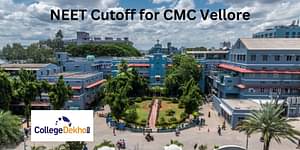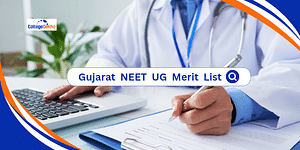MD Course Syllabus & Subjects 2023
MD syllabus includes both core and elective subjects over the course of 6 semesters. Some of the important MD subjects are Myology, Osteology, General Histology, Comparative Embryology, Anthropology, Radiological Anatomy, Systemic Anatomy, etc. The Doctor of Medicine syllabus is vast and comprehensive in regards to the specializations offered in the field of Medical Sciences.
Doctor of Medicine Syllabus & Subjects Overview
The Doctor of Medicine, also known as the MD degree, is a professional postgraduate doctorate that prepares students for careers in research or clinical practice. It allows candidates to perform advanced research on contemporary medical challenges. It also prepares students to be leaders in their field. The degree may also include research conducted before enrollment but not submitted for a previous degree. It is a demanding programme that necessitates a strong work ethic and commitment to a professional career.
On an average, the duration of Doctor of Medicine Course programme is usually 3-4 years and includes medical school and residency programmes. The course curriculum includes a range of core and elective subjects as per the prescribed Doctor of Medicine syllabus and the completion of a residency programme. Thus, in total, the MD course lasts anywhere from 3 to 7 years. Let us dig deep into the Doctor of Medicine syllabus and subjects for aspirants to have a clear understanding of the course.
Table of Contents
- Doctor of Medicine Syllabus & Subjects Overview
- Doctor of Medicine Course Structure
- Doctor of Medicine Year Wise Syllabus
- Doctor of Medicine Important Subjects
- Specialisations offered in Doctor of Medicine (MD)
- Doctor of Medicine Entrance Exam Syllabus
- Doctor of Medicine Subjects and Syllabus: Important Books
Doctor of Medicine Course Structure
Let us decode the course structure of this postgraduate medical degree for candidates before diving into the Doctor of Medicine syllabus and subjects.
Traditional classroom-based teaching approaches as well as practical lab workshops are used in the MD programme. Traditional teaching methods allow students to learn about a topic in greater depth and detail, allowing them to ask any questions they may have.
The lab workshops allow students to apply their academic knowledge in a practical situation while also clarifying any doubts. Furthermore, the students can apply this knowledge throughout their six-month internships. The following are general teaching methodologies and strategies:
- Lectures
- Theory Papers
- Clinical/Practical
- Oral/Viva Examinations
- Group Discussions
- Thesis
- Seminars
- Journal Clubs
- Participation in the Laboratory and Experimental Work
Thesis
Every postgraduate student must work on an allocated research project under the supervision of a recognised Post Graduate Teacher, the results of which must be written up and submitted as a Thesis. The work for writing the thesis is intended to contribute to developing a curious spirit and expose the postgraduate student to research techniques, critical analysis, familiarity with the most recent advances in medical science, and the manner of identifying and consulting available literature.
Theory
There will be four theory papers, which are listed below:
- Paper I: Fundamental Medical Sciences (at the end of the first year of training)
- Paper II: Medicine and related fields such as paediatrics, dermatology, and psychiatry
- Paper III: Tropical Medicine and Infectious Diseases
- Paper IV: Recent Medical Advances
Clinical/Practical and Oral/Viva Examination
The final clinical examination should include:
- Cases involving major systems.
- Clinical, procedural, and communication skill stations
- Day-to-day observation and log book records during training.
- The oral/viva voce examination must be thorough enough to assess the postgraduate student's overall knowledge of the subject.
Illustration of Structured Training
| Time Period | Description/Levels | Content Advanced | Responsibilities |
|---|---|---|---|
| First Month | Orientation | Basic cognitive skills |
|
| First Year | Beginners | Procedural abilities OPD & ward work |
|
| Second Year | Intermediate | Intermediate degree of cognitive abilities, Specialised procedural skills, Emergency |
|
| Third Year | Advanced | Special skills, Intensive critical care |
|
Note: Patient safety is of the utmost importance during the training programme; so, skills have to be learned first on models, then under supervision, and finally independently; provision of skills laboratories in most Indian medical institutions and colleges is necessary for this purpose.
Doctor of Medicine Year Wise Syllabus
The Doctor of Medicine syllabus covers a wide range of themes and courses such as haematology, clinical pathology, community medicine, ophthalmology, and so on, and is spread out over six semesters or three years. The curriculum is nearly identical in all Indian universities and colleges. The following is the general Doctor of Medicine syllabus:
First-Year Doctor of Medicine Syllabus
The first-year resident should be taught how to manage ASA I and II patients. Under graded supervision, they will first observe and then gradually become independent in providing general anaesthesia and spinal anaesthesia to ASA I and II cases for minor and major surgery. They should spend their first year in the following specialities: gynaecology, general surgery, orthopaedics, ENT, recovery room, and urology.
| Semester I | Semester II |
|---|---|
| Recent Advances In Medicine | Diagnostic Investigation and Procedures |
| Applied Basic Science Knowledge | Biostatistics and Clinical Epidemiology |
| Diseases Concerning General Medicine | - |
Second-Year Doctor of Medicine Syllabus
Under supervision, the student should be trained to provide general anaesthesia, and regional anaesthesia to ASA I, II, III, and IV, as well as an extradural block (EDB), spinal block, and peripheral nerve blocks. The second-year Doctor of Medicine syllabus will train students in paediatric and trauma life support, as well as basic and advanced cardiac life support. They are advised to work in the following specialities: Obstetrics, Dental Surgery, Eye, ICU, Pain Clinic, and Peripheral Theatres. The student must be able to examine data and produce a thesis. It is necessary to be able to communicate scientific data.
| Semester III | Semester IV |
|---|---|
| Counselling Patients and Relatives | Ward Patient Management |
| Ability To Teach Undergraduate Students | Ability to Carry Out Research |
| Monitoring Seriously Ill Patients | Opd Patient Management |
Third-Year Doctor of Medicine Syllabus
The student should be able to arrange and provide anaesthesia to all patients under graded supervision, including those undergoing cardiac, neurosurgery, paediatric surgery, and major surgery. The goal of the second-year Doctor of Medicine syllabus is to be competent and independent in giving anaesthesia to elective and emergency cases by the third year of junior residency. The junior resident should be able to manage critically ill patients and treat intractable pain. They should also know how to plan mass casualties. The syllabus should be able to provide one month of elective posting.
| Semester V | Semester VI |
|---|---|
| Ward Rounds, Case Presentations, and Discussions | PG Case Presentation Skills |
| Long and Short Topic Presentations | Journal Conferences |
| Clinico-Radiological And Clinicopathological Conferences | Research Review |
Doctor of Medicine Important Subjects
Some of the most important Doctor of Medicine subjects that aspirants study are discussed below:
Anatomy
The subject of human anatomy or simply anatomy is the study of the composition and organisation of the human body. This degree's curriculum includes the following topics:
| Osteology | Anthropology | Myology | Systemic Anatomy |
|---|---|---|---|
| Applied and Clinical Anatomy | Comparative Embryology | Systemic Anatomy | General and Systematic Embryology |
| General Histology | Staining Procedures | The Evolutionary Process | Comparative Anatomy |
| Physical Anthropology | Gross and Regional Anatomy | Genetic Principles | Radiological Anatomy |
Biochemistry
This subject covers fundamental principles and recent advances in the discipline, as well as metabolic and molecular medicine and research methods. It teaches trainees how to plan and integrate teaching programmes in medical and nursing schools, how to set up and operate a diagnostic testing lab, how to create, analyse, and understand diagnostic laboratory data, and how to connect with healthcare professionals to improve patient care.
Microbiology
The study of microorganism-human-organism interactions is covered in this subject in the Doctor of Medicine syllabus. By providing a dimension-based education, the curriculum is subjective and allows students to be more practical. The programme develops a competent expert and medical professional who recognises community health needs and performs all professional tasks appropriately.
Pathology
Pathology is the subject in the Doctor of Medicine programme that studies the organs, tissues, physiological fluids, and entire bodies to diagnose illnesses. It is essential in all aspects of patient care, from diagnostic testing and treatment suggestions to cutting-edge genetic technologies and disease prevention.
Pharmacology
The primary emphasis of this Doctor of Medicine subject is to investigate the efficacy of various drugs in treating a wide range of ailments in live beings. According to the National Medical Council, the curriculum includes clinical and experimental sciences. Clinical pharmacology entails administering medications to patients, researching the side effects of such therapies, conducting clinical studies, and pharmacovigilance. In contrast, experimental pharmacology is concerned with developing new medications and studying their effects.
Physiology
It investigates how typically functioning biological systems function. This subject also addresses the fundamentals of abnormal function in human sickness, which is required for treating such diseases through translational research and the development of novel treatments.
Anaesthesiology
This subject focuses on how to minimise the intensity of pain by employing drugs that dull one's senses to it. It is intended for students who want to work in the preoperative context, pain management, or emergency medicine. It contributes to the field of anesthesiology by committing to learning, scientific studies, and scholarly activities.
Community Medicine
This Doctor of Medicine subject investigates the factors that contribute to disease in populations, the natural history of the disease, and the effects of the natural environment and human civilization on health and sickness. Students will leave the seminar better prepared to assess their communities' health needs, fulfil their professional duties ethically, and align their actions with national health policy goals.
General Medicine
Internal medicine is a branch of medicine that focuses on the diagnosis and (non-surgical) treatment of illnesses affecting the internal organs of the body (especially in adults). The subject includes, but is not limited to, applied fundamental scientific knowledge, diagnostic investigation and procedures, outpatient department (OPD) treatment, biostatistics and clinical epidemiology, practicals, conferences, research, and other topics.
Paediatrics
This subject covers the diagnosis of newborns, children, and adolescents, as well as professional responsibilities in accordance with the National Health Policy and professional morals.
Tuberculosis and Chest
This Doctor of Medicine course subject deals with respiratory tract diseases and teaches students about preventing, diagnosing, and treating conditions affecting the lungs, bronchial tubes, and respiratory system, including the nose, pharynx, and throat. The programme's purpose is to prepare students for jobs in internal medicine, which focuses on these areas primarily.
Apart from the aforementioned subjects, other subjects that are a part of the Doctor of Medicine syllabus are as follows:
- Biophysics
- Community Medicine
- Dermatology and Venereology
- Forensic Medicine and Toxicology
- Laboratory Medicine
- Nuclear Medicine
- Obstetrics & Gynaecology
- Ophthalmology
- Physical Medicine & Rehabilitation (PMR)
- Psychiatry
- Radio-Diagnosis
- Radiotherapy
Specialisations offered in Doctor of Medicine (MD)
There are over 60 medical specialisations and 30 subspecialties, making it difficult for doctors to choose their concentration. Doctors might choose their medical speciality based on their interests. However, there are factors such as demand, scope, salary, and availability of the MD medical seat to consider.
Decision-making would be more difficult in such a situation. However, your choice will determine whether you have a fulfilling or disheartening job. As a result, exercise caution when selecting your medical specialisations. In India, the top MD specialisations listed below that are in high demand and have a broader scope.
Doctor of Medicine in Aerospace Medicine
The goal of training students for an MD in Aerospace Medicine is to develop a postgraduate student who, after completing the necessary training, can deal with the community's needs and should be competent to handle all. The student should also learn how to teach medical/para-medical students about the subject in which the candidate has obtained training. The Doctor of Medicine syllabus for Aerospace Medicine includes subjects like:
- Applied Physics, NVG Training and Biodynamics
- Medical Electronics, Biomedical Engineering and Instrumentation
- Biostatistics and Research Methodology
- General Physiology with Biochemistry
- High Altitude Physiology and Hyperbaric Medicine
- Acceleration and Vestibular Physiology
- Civil Aviation Medicine
- Aviation Otorhinolaryngology, etc.
Doctor of Medicine in Anatomy
This specialisation allows students to learn how to teach anatomy to medical and paramedical students, as well as how to blend anatomy instruction with other important courses while remaining cognizant of their limits. The Doctor of Medicine syllabus for Anatomy includes subjects like:
- Gross Anatomy
- Cell Biology
- Microscopic Structure of the Body
- Neuroanatomy
- Genetics
- Immunology
- Surface Marking and Radiology
- Forensic Medicine, etc.
Doctor of Medicine in Anaesthesia
Students with anesthesiology training should be able to identify community health needs. The candidate should be qualified to handle medical problems effectively and be aware of recent breakthroughs in the respective field. They should be a highly proficient anesthesiologist with a diverse set of skills that will allow them to practise anesthesiology independently. Students should also learn the fundamentals of educating medical/para-medical students. They must also be familiar with the principles of research techniques and the modalities of the consulting library. They should attend conferences, workshops, and CMEs regularly to keep their expertise up to date. Some of the core subjects that are part of the Doctor in Medicine syllabus specialised in Anaesthesia are:
- Anatomy
- Physics
- Physiology
- Pharmacology
- Biochemistry
- Biostatistics
- Blood Coagulation Mechanism
- Principles of Anaesthetic Management
- General Principles of Medical Audit, etc.
Doctor of Medicine in Biochemistry
The student who has achieved a Doctor of Medicine degree in Biochemistry should be well-versed in basic principles and recent breakthroughs in the topic, as well as in numerous laboratory procedures applicable to metabolic and molecular aspects of medicine, as well as in research methodology. The training provides the student with the skills needed to become an effective teacher, capable of planning and implementing teaching programmes for students in medical and allied health science courses, setting up/managing a diagnostic laboratory, generating, evaluating, and interpreting diagnostic laboratory data, interacting with clinicians to contribute to more effective patient care, and carrying out and publishing a research project. Some of the most important subjects that aspirants study in this course are:
- Biomolecules
- Cell Biology
- Biochemical Techniques
- Biostatistics and Research Methodology
- Basics of Medical Education in Teaching
- Biochemistry
- Enzymes
- Bioenergetics
- Biological Oxidation
- Intermediary Metabolism and Regulation
- Inborn Errors of Metabolism and Nutrition, etc.
Doctor of Medicine in Community Medicine
Community Medicine is a specialisation and a branch of medicine that deals with the promotion of health and illness prevention by incorporating people and applying professional management abilities. The Community Medicine expert will instil a holistic approach to health and medical interventions that are largely focused on Community Health/Population Health. As a result, the candidate should have knowledge, skills, and competencies in primary, secondary, and tertiary care, outbreak and epidemic control and prevention, community diagnosis, health need assessment, epidemiological assessment, research, and creating evidence-based health policies and programmes. Some of the important subjects that are part of this Doctor of Medicine syllabus are as follows:
- Conceptual (and applied) Understanding of Public Health
- Community Medicine
- Clinical Disease-Oriented Approach
- Preventive Approach & Health Promotion
- Disease Control & Promotion
- Communicable and Non-Communicable Diseases
- Emerging and Re-Emerging Diseases
- Applied Epidemiology
- Health Research
- Biostatistics
- Environmental Health, etc.
Doctor of Medicine Entrance Exam Syllabus
Students who have completed medical school may pursue a Doctor of Medicine (MD) degree, which is a three-year post-graduate degree programme. NEET PG and INI CET are two widely used medical school entrance exams. Students must have completed an MBBS degree with a minimum of 50% to be eligible for these exams.
NEET-PG
The Nationwide Eligibility Cum Entrance Test - NEET PG is a national-level entrance test used by medical institutes across the country as an eligibility condition for postgraduate medical courses such as MD, MS, PG Diploma, and DNB CET. The National Board of Examinations administers the exam (NBE). NEET PG scores are accepted by medical schools and hospitals across the country. The entrance exam is divided into three sections: Parts A, B, and C. The subjects covered in each phase are also summarised here:
| Phases | Topics/Subjects Included |
|---|---|
| Phase I - Pre-Clinical Subjects |
|
| Phase II - Para-Clinical Subjects |
|
| Phase III - Clinical Subjects |
|
INI-CET
The All India Institute of Medical Sciences, New Delhi, administers the INI CET, a national-level postgraduate medical entrance examination. The exam, which was implemented in 2020, has replaced the postgraduate medical entrance exams of four national institutions: AIIMS PG, JIPMER PG, PGIMER, and NIMHANS.
INI CET is a single entrance exam for postgraduate courses like MD, MS, MDS, MCh, and DM courses at all AIIMS institutes, as well as JIPMER, PGIMER, and NIMHANS. The exam will be given twice a year, in January and July. Candidates can check the syllabus INI CET AIIMS syllabus for reference below.
| Subjects/Topics | INI CET AIMS Syllabus |
|---|---|
| Pre-Clinical | Biochemistry, Physiology, Anatomy |
| Para-Clinical | Pharmacology, Pathology, Forensic Medicine, Microbiology, Community Medicine, etc. |
| Clinical | Obstetrics, Paediatrics, Gynaecology, Community Medicine, Medicine and allied subjects (Psychiatry, Dermatology), etc. |
| Surgery and Allied Subjects | Orthopaedics, Ophthalmology, E.N.T., Anaesthesiology, etc. |
Doctor of Medicine Subjects and Syllabus: Important Books
There are a plethora of books in the market that graduates have to refer to while pursuing their Doctor of Medicine specialisation. Having said that, here is a brief list of some of the reference books that aspirants can refer to for completing their Doctor of Medicine syllabus and subjects:
- API Textbook of Medicine
- Davidson’s Principles and Practice of Medicine
- Harrison’s Principles & Practice of Medicine
- Oxford Textbook of Medicine
- Kumar & Clark: Book of Clinical Medicine
- Cecil: Textbook of Medicine
- Braunwald’s Heart Disease
- Hurst’s The Heart
- Sheila Sherlock’s Diseases of the Liver and Biliary system
- Adams and Victor’s Principles of Neurology
- Crofton and Douglas Respiratory Diseases
- Brenner and Rector’s The Kidney
- Williams Textbook of Endocrinology
- Mandell’s Principles and Practice of Infectious Diseases
- Kelley’s Textbook of Rheumatology
- Devita’s Principles and Practice of Oncology
- Textbook of Critical Care Medicine
- Shamroth’s an Introduction to Electrocardiography


















